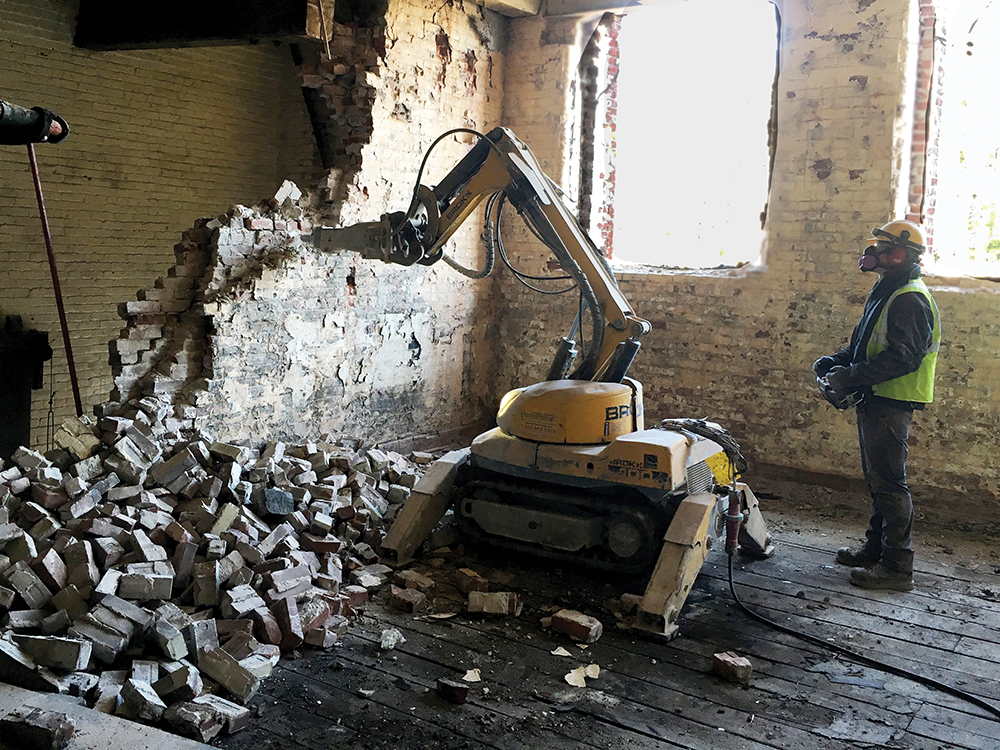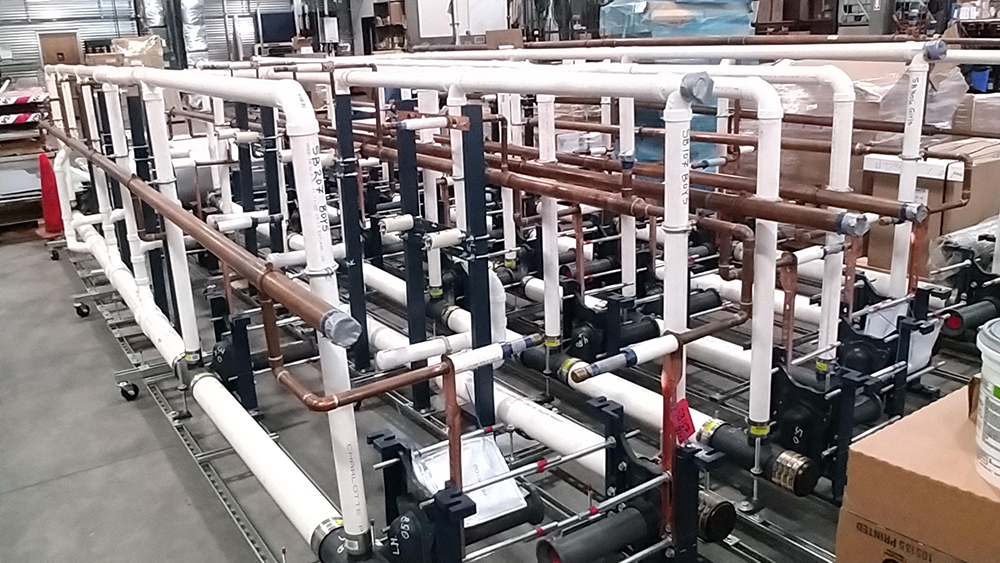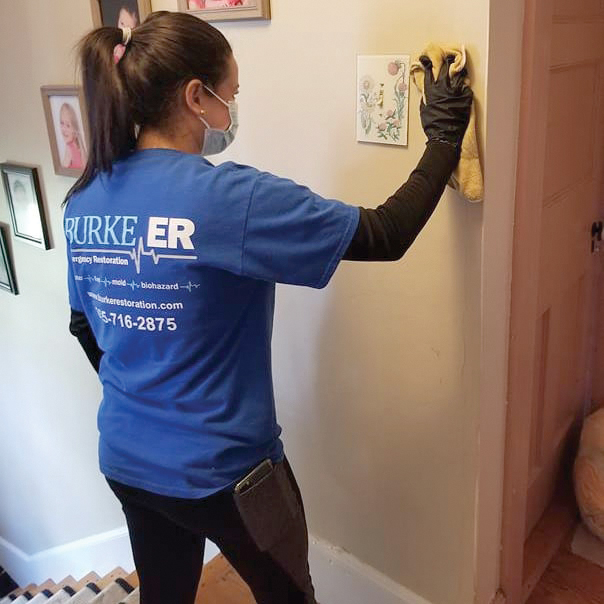
Braden McAlpine says he was always a hands-on person. Growing up, he often helped his grandmother around the house. He painted. He fixed toilets and faucets. He built garden beds, tables and barn doors.
He received a more formal education in the trades during high school. Attending Pembroke Academy, he took framing, electrical and masonry classes through the Concord Regional Technical Center. When he tried HVAC, through a course at Manchester Community College, he “got hooked.”
Through ApprenticeshipNH, a program under the community college system, McAlpine shadowed workers at several HVAC firms. He started working for one of them, MSI Mechanical in Salem, full time this year, installing heating and cooling units on rooftops.
For McAlpine, 18, of Pembroke, the trades felt like the right fit. “I wanted to be involved in what I’m doing,” he says. “Always moving, really putting things together and seeing the finished product.”
The construction industry is looking for more Bradens. Spurred by a long-running labor shortage that’s only worsened during the pandemic, NH companies and industry groups are trying to attract a new generation of workers to the building trades.
Experts and people in the industry agree there’s no quick fix. But they say that over time, apprenticeships, outreach to underrepresented groups and better promotion of the trades can all help lay the foundation for a more robust workforce.
“As a society, we’ve not done enough good work to communicate the benefits of working in construction and working with your hands,” says Joshua Reap, president and CEO of Associated Builders and Contractors, NH and Vermont chapter.
A Longtime Labor Crunch
The construction industry was already facing a workforce crunch before 2020 due to an aging workforce, more young people being steered toward college and workers who left the industry during the 2008 recession and never returned, says Zachary Fritz, an economist with Associated Builders and Contractors (ABC).
Then, during the pandemic, some older workers retired early and the tight overall labor market meant fewer job seekers all around. Meanwhile, a home-building boom created even more demand.
In February, ABC estimated the industry would need to add around 650,000 new workers in 2022 and 590,000 more in 2023—on top of normal hiring—to meet the projected demand for construction.
And those numbers don’t capture a growing skills gap. During the last decade, the number of unskilled, entry-level construction laborers grew much faster than those in the skilled trades, according to Fritz.
“There’s been a serious shortfall of skilled trade workers and workers in the prime of their career in the construction industry,” he says.
And many others are nearing retirement. New Hampshire has the second-oldest construction workforce in the country, with a median age of 46, according to a report from the Home Builders Institute last year.
Companies are feeling the pinch. As of August, Palmer & Sicard, an Exeter-based mechanical contractor, employed about 100 people. Between plumbers, sheet-metal installers and HVAC technicians, it could have used 15 more, according to President Mark Hodsdon.
“It’s really a struggle for us to find all the help we need to complete all the work that we’ve got on the books right now,” he says. “We’re at the point of using head hunters to find tradespeople, and even that comes with minimal success.”
With subcontractors booked out, construction managers are having to adjust project timelines, says Preston Hunter, a vice president at Bedford-based Eckman Construction. “The subcontractors can be very picky in terms of which projects they choose to bid, and their prices reflect that their schedules and calendars are nearly always full,” he says. “So, we’re having to encourage owners to allow us to go out to bid on their projects earlier and to be flexible about start dates.”
Labor shortages have pushed some companies to invest in equipment that saves time on the job site but wasn’t previously cost-effective, including robotic demolition equipment and expensive drill attachments that cut the time it takes to run cable, Reap says. “With the shortage of labor, you buy certain pieces of technology like that to make it go quicker.”

An EnviroVantage employee operates a robotic demolition machine.(Courtesy of EnviroVantage)
Prefabricating components can also save time and labor on the job site. Hodsdon says Palmer & Sicard has increasingly used prefabrication for that reason. For example, he says, one of its bathroom configurations might take two workers a week to build onsite. In the shop, a single worker can put it together in two or three days.
 Prefabricated components in the shop at Palmer & Sicard. (Courtesy of Palmer & Sicard)
Prefabricated components in the shop at Palmer & Sicard. (Courtesy of Palmer & Sicard)
But technological innovations and efficiency gains aren’t a cure-all for the labor squeeze, Hunter cautions. “At the end of the day, buildings are built by humans,” he says. “ So there really is no technology that can replace the need for skilled people in the trades.”
Building New Career Paths
Edward Curran went right into the building trades after he graduated high school in 1999, working on HVAC systems. It was rewarding, challenging work that paid well. He had no student loan debt. He bought a house at 23.
“But that wasn’t what the counselors wanted,” he recalls. “If you had decent grades in school, they pushed you toward continuing on, post-secondary, and getting a bachelor’s degree, not going into the technical trades.”
Curran didn’t listen. He has worked in the industry for two decades, and now chairs the HVAC program at Manchester Community College. But for a long time, such attitudes steered many young people away from the trades, contributing to the current lack of labor.
Curran and others say those views have started to change in the last several years. “What I see in some of the K-through-12 education is this realization of, ‘There are many different paths to success for young people,’” says Tim Taylor, director of research at the National Center for Construction Education and Research.
Companies, schools and industry groups are creating new pathways into construction for young people who like working with their hands. New Hampshire’s Community College System and industry partners formed an HVAC apprenticeship about three years ago and a carpentry apprenticeship launched in February. After piloting the carpentry program in Manchester, organizers say they hope to expand it to the rest of the state soon.
“Businesses were forced to look at the apprenticeship as an option because they couldn’t find any skilled labor out there,” Curran says. “It’s not an immediate stopgap for your labor shortage, but it’s another option for ensuring that, in the future, you have a skilled labor force.”
Brian Hooper, vice president of operations at MSI Mechanical, says the HVAC contractor has had success with a long-running “school-to-career program” at Blackstone Valley Tech, a vocational high school in Upton, Mass.
“That to me is the answer to labor shortages, is that every company should be adopting their own local high schools and going in and really advocating to the guidance department at each school,” he says.
José Manuel Lopes of Milford, Mass., connected with MSI while attending Blackstone Valley Tech, which gave students opportunities to go out into the field with companies. Now 31, Lopes is still working for MSI as an HVAC technician.
“I’ve always been taking bikes apart, or any motorized stuff, so I’ve always been a mechanically inclined person,” Lopes says. His experience in high school “just helped fuel it. I was grabbed, and from there on I kept doing it.”
Companies and trade groups are also working to broaden the industry’s appeal. Matt Mayberry, executive vice president of the NH Home Builders Association, says he’s promoted construction in communities of color and the LGBTQ community, including at this year’s Manchester Pride parade.
The same message resonates across demographic groups, he says: “If you want to be your own boss, this is an opportunity for you to control your own destiny — and make a really great living at it.”
One priority for the industry is recruiting more women, who made up just 10.9% of the national construction workforce in 2020, according to the Home Builders Institute. Christine Burke, co-owner of Burke Emergency Restoration in Manchester, says introducing students to the trades in high school is essential to attracting more young women.
“For example, when you expose a young woman to the electrical trade, she may never have heard of it or even thought to go into that,” she says. “But maybe she takes a course in the high school level and says, ‘Gee, I’ve got a real talent for this, and I can make a good living.’”

A female crew worker at Burke Emergency Restoration removes soot from a fire-damaged wall. (Courtesy of Burke Emergency Restoration)
Efforts are also underway to launch a carpentry apprenticeship for people incarcerated in NH prisons, according to Mayberry. “If you leave the corrections system in New Hampshire, you’re stigmatized,” he says. “But they’d be very welcome into a trade skillset where they could be their own boss, they can make their own money, and they can get back on track.”
Some analysts have also pointed to immigration reform as a way to ease construction’s labor shortage. Immigrants account for about one-quarter of the construction workers nationally, according to the Home Builders Institute, but the number of immigrants entering the industry declined during the Great Recession and again in the first years of the Trump administration.
McAlpine, the new MSI employee, encourages other young people to consider the trades. The work is interesting and well-paid, and job opportunities abound, he says. “We need more help than we’re getting, that’s for sure,” he says. “I know every single company is looking for more people.”

 Current Issue - July 2024
Current Issue - July 2024